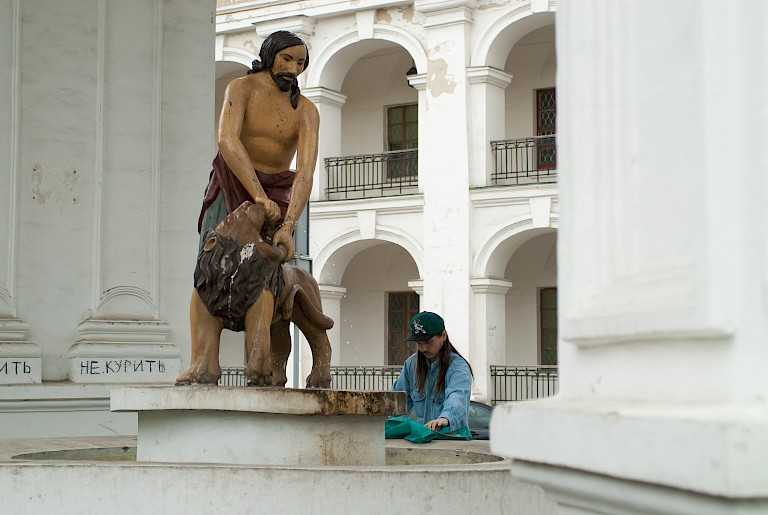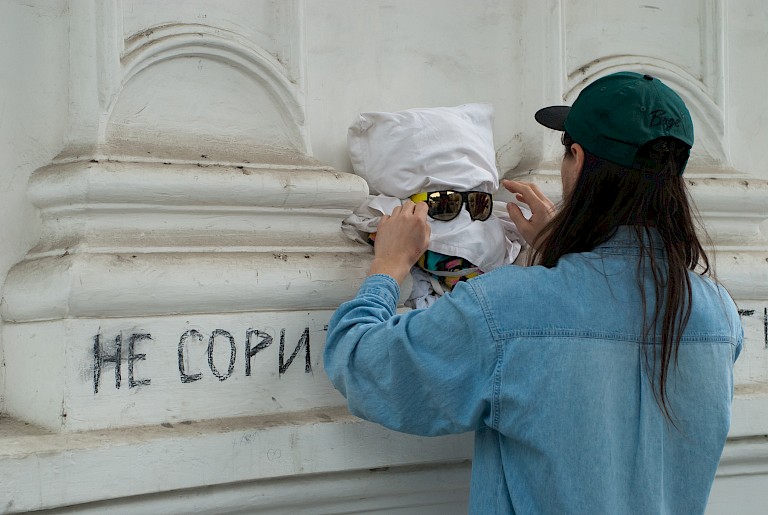



What indeed Vova Vorotniov implemented within Samson was an explicit proof that individual tactics can construct a public artwork, even if in the end it does get an institutional authorization. Known for his curatorial work as an artistic director of Muralissimo graffiti festival in Kyiv, Vova has been creating personal non-institutional projects for at least a decade – conceptual murals and installations in Ukraine, Poland, Belgium, France and the Netherlands. This is the exact case in point of re-establishing a certain place in the public eye, even if this sudden functional shift was transient in time.
Moreover, the project’s location had a particular civic meaning: the architectural legacy of Podil, the old part of Kyiv where Samson pavilion is situated, is currently endangered by private property developers and city municipality. Baroque and neoclassical 17th – 18th century constructions do not get proper restoration and/or become subjected to commercial renovation, which depreciates their historical value. In addition, many of mentioned manipulations limit public access to these constructions. When Vova Vorotniov conducts his Dadaist activities around one of such urban sites, it provides the pavilion with a new portion of attention within the artistic context. In a way, by bringing pop and absurd into the public space, artistic activities keep it from sinking in paranoid neutrality and destructive social automatism.
As a part of the Samson project, Vorotniov made a series of spontaneous interventions bordering on site-specific and street art in which the Samson fountain was both a public exhibition space and a photo studio. Open to the spontaneous contemplation of passersby, the results of the intervention were documented and illustrated particular aspects of this place and general problems of the public space. “I also wanted to draw a parallel between baroque excess, overproduction, and the functionality of consumer products in our time”, says the artist. The culmination of the project was a public lecture in which he tried to outline the project’s goals and the range of issues that led the artist to it.
The project offered new functions of the Samson pavilion: social (lectures) and expositional (exhibition with documentation). Working openly in a public space, the artist’s goal was to become an added component to the place in the perception of the random spectator, clearly illustrating the practice of artistic invasion and thus expanding the traditionally ambivalent, alienating perception of the street by the average person. This location also inspired several improvisational actions. One of them was “Vedel’s House”: for an hour the artist played the music by the 18th century Ukrainian composer Artemiy Vedel on a ghetto blaster — a symbol of street youth (sub) culture.
Samson project resulted in the new understanding of practical opportunities to overcome the alienation of Kyiv’s modern public space through local, contextual, and, most importantly, systematic interventions aimed at redefining street objects, at exploiting their functional resources, at their actualization and realization.
The project grew from an assignment to research the historical areas of Kyiv and work with corresponding public spaces. Vova Vorotniov implemented it with a minimal budget, as the project mostly required direct personal engagement rather than production expenses. It attracted a comparatively large number of spontaneous participants from different social strata.
All copyright belongs to Shanghai Academy of Fine Arts, Shanghai University.



